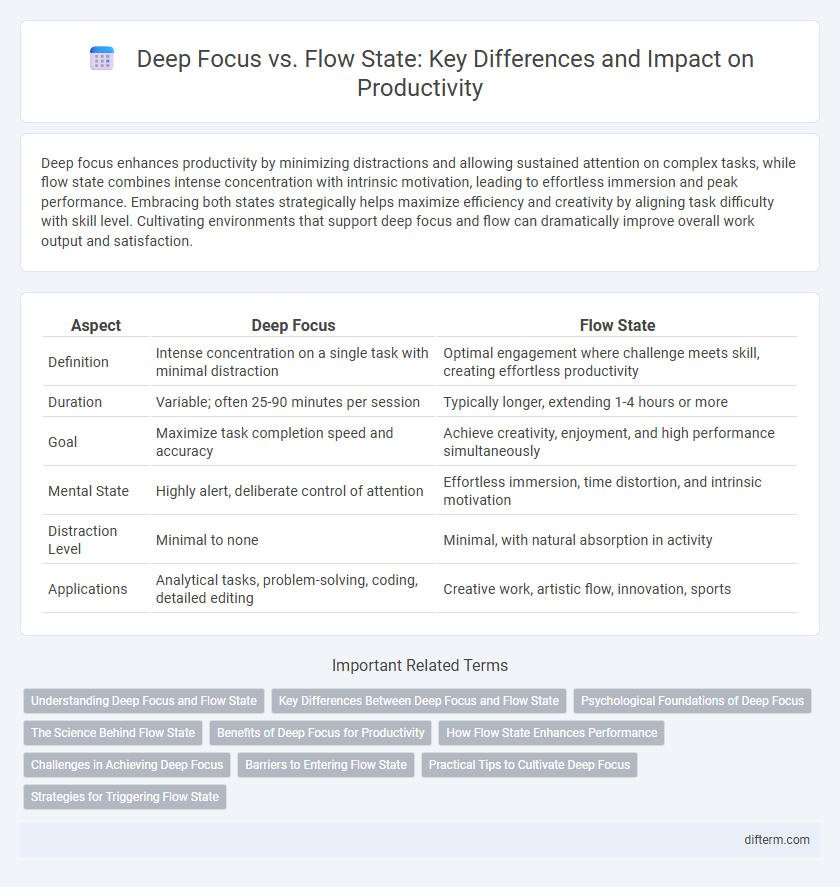Deep focus enhances productivity by minimizing distractions and allowing sustained attention on complex tasks, while flow state combines intense concentration with intrinsic motivation, leading to effortless immersion and peak performance. Embracing both states strategically helps maximize efficiency and creativity by aligning task difficulty with skill level. Cultivating environments that support deep focus and flow can dramatically improve overall work output and satisfaction.
Table of Comparison
| Aspect | Deep Focus | Flow State |
|---|---|---|
| Definition | Intense concentration on a single task with minimal distraction | Optimal engagement where challenge meets skill, creating effortless productivity |
| Duration | Variable; often 25-90 minutes per session | Typically longer, extending 1-4 hours or more |
| Goal | Maximize task completion speed and accuracy | Achieve creativity, enjoyment, and high performance simultaneously |
| Mental State | Highly alert, deliberate control of attention | Effortless immersion, time distortion, and intrinsic motivation |
| Distraction Level | Minimal to none | Minimal, with natural absorption in activity |
| Applications | Analytical tasks, problem-solving, coding, detailed editing | Creative work, artistic flow, innovation, sports |
Understanding Deep Focus and Flow State
Deep focus is a cognitive state characterized by intense concentration on a single task, minimizing distractions to enhance productivity and accuracy. Flow state, defined by psychologist Mihaly Csikszentmihalyi, involves complete immersion and enjoyment in an activity where skill level and challenge are balanced, often leading to increased creativity and intrinsic motivation. Understanding the distinction between deep focus and flow state helps optimize task engagement by leveraging sustained attention for analytical tasks and immersive involvement for creative or complex problem-solving activities.
Key Differences Between Deep Focus and Flow State
Deep focus involves sustained attention on a specific task, minimizing distractions to enhance cognitive control, while flow state combines intense concentration with intrinsic motivation, resulting in seamless task engagement and altered perception of time. Deep focus primarily relies on conscious effort to maintain focus, whereas flow state emerges naturally when skill level matches the challenge, creating an optimal experience. The key differences lie in the mental control required and the psychological experience: deep focus demands deliberate concentration, whereas flow generates effortless immersion and enjoyment.
Psychological Foundations of Deep Focus
Deep focus relies on sustained attention by minimizing distractions and maximizing cognitive control, enabling the prefrontal cortex to regulate task-relevant information effectively. This psychological state is grounded in attentional networks that suppress irrelevant stimuli and enhance working memory capacity, promoting deeper information processing. Neurochemical factors such as increased dopamine and norepinephrine levels further support the neural mechanisms underpinning prolonged concentration and goal-directed behavior.
The Science Behind Flow State
Flow state activates the brain's prefrontal cortex, reducing activity in the dorsolateral prefrontal cortex, which decreases self-doubt and time awareness, enhancing deep immersion in tasks. Neurotransmitters like dopamine, norepinephrine, and endorphins surge during flow, improving mood, motivation, and cognitive function. Scientific studies link flow state to increased neural efficiency and better working memory, driving peak productivity and creativity.
Benefits of Deep Focus for Productivity
Deep focus enhances productivity by minimizing distractions and allowing sustained attention on complex tasks, leading to higher-quality work and faster completion times. It strengthens cognitive control and memory retention, enabling deeper problem-solving and innovative thinking. Consistent deep focus sessions improve overall mental stamina, reducing the time spent switching between tasks and boosting long-term efficiency.
How Flow State Enhances Performance
Flow state enhances performance by creating a seamless fusion of action and awareness, allowing individuals to fully immerse in tasks with optimal concentration and minimal distractions. This heightened mental engagement increases cognitive efficiency, leading to faster problem-solving, improved creativity, and consistent productivity boosts. Compared to deep focus, flow state sustains motivation and enjoyment, fostering longer periods of peak performance.
Challenges in Achieving Deep Focus
Achieving deep focus challenges many due to constant digital distractions, multitasking demands, and cognitive fatigue. The brain's limited capacity for sustained attention complicates prolonged concentration on complex tasks necessary for deep work. Developing environments that minimize interruptions and practicing mindfulness techniques are essential strategies to overcome these obstacles.
Barriers to Entering Flow State
Barriers to entering the flow state include distractions, lack of clear goals, and insufficient skill-challenge balance, which prevent deep focus essential for peak productivity. External interruptions and internal anxieties disrupt concentration, making it difficult to achieve sustained immersion in tasks. Creating an environment that minimizes interruptions and aligns task difficulty with personal abilities enhances the likelihood of reaching a flow state.
Practical Tips to Cultivate Deep Focus
Establishing a distraction-free environment by turning off notifications and setting specific time blocks enhances deep focus, allowing for sustained, high-quality work sessions. Prioritizing single-tasking over multitasking minimizes cognitive overload and strengthens concentration on complex tasks. Incorporating regular breaks using techniques like the Pomodoro method helps maintain mental clarity and prevents burnout during deep focus periods.
Strategies for Triggering Flow State
Triggering flow state involves creating an environment with minimal distractions and setting clear, challenging goals to enhance deep focus. Techniques such as time blocking, using the Pomodoro method, and engaging in mindfulness practices help maintain sustained concentration. Consistent routines and immediate feedback loops also optimize mental engagement, facilitating seamless entry into flow.
Deep focus vs Flow state Infographic

 difterm.com
difterm.com